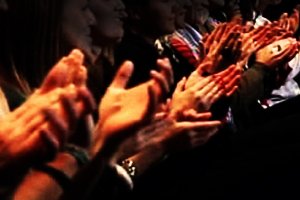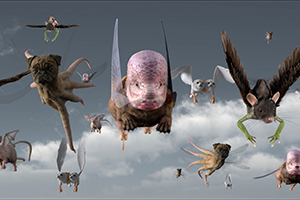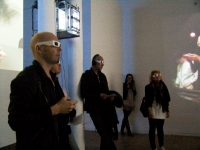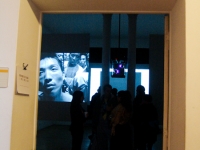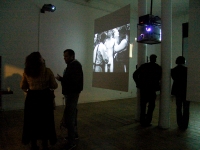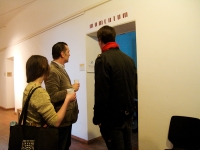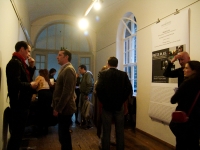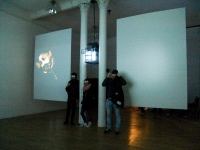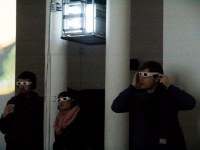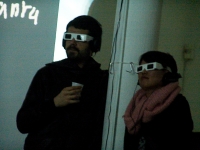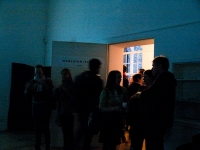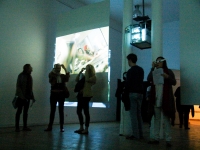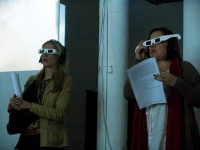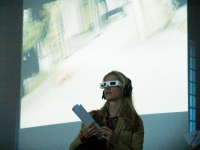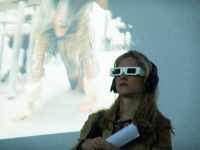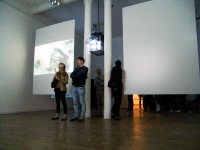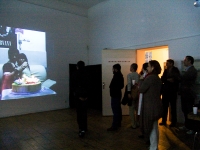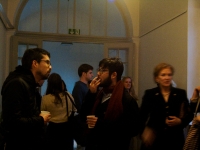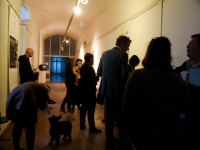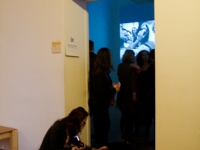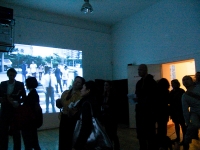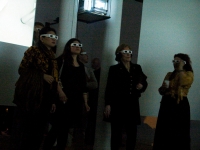 |
 |
 |
DSLCOLLECTION
PRESS PLAY: NEW PERSPECTIVES IN CONTEMPORARY CHINESE ART
OPENING APRIL 24
EXHIBITION APRIL 25 – JUNE 17
Curated by Rachel Rits-Volloch and Cassandra Bird
Featuring: Cao Fei, Chen Chieh Jen, Liang Juhui, Zhang Peili, Cui Xiuwen, Jiang Zhi
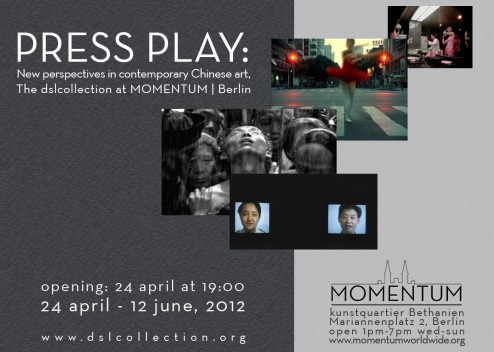
PRESS PLAY: New Perspectives in Contemporary Chinese Art, The dslcollection at MOMENTUM | Berlin
“A collection cannot survive in isolation. It needs to be heard, to be seen and most importantly, to be experienced.” (Sylvain Levy)
PRESS PLAY: New Perspectives in Contemporary Chinese Art brings six outstanding video works from the dslcollection to MOMENTUM | Berlin. Framed around the 3D exhibition curated by Martina Koppel Yang, MOMENTUM shows the video works featured in dslollection’s virtual museum. While the 3D film contextualizes these works within the broader framework of the dslcollection and the development of Chinese contemporary art, MOMENTUM enables the experience of direct contact between the viewer and the artwork. PRESS PLAY: New Perspectives in Contemporary Chinese Art explores the balance between our experience of an artwork and the mediated document of that artwork. Presenting an innovative model of exhibition practice with a 3-dimensional immersive experience of a virtual museum, alongside the video works themselves, PRESS PLAY highlights the integral role of time in the experience of art. We need to give any artwork time to see it in all its complexity, to understand it on both a mental and emotional level. This is especially true in the case of time-based media, such as video art. As a collection needs to be heard, to be seen, and to be experienced in order to acquire meaning, the 3D film acts as a contextualising counterpoint to the works themselves, allowing them to be understood within the broader framework of the dslcollection.
In joining forces with the dslcollection, MOMENTUM is proud to collaborate with a cutting edge collection, at the forefront of contemporary Chinese art and of utilizing new technologies in exhibition practice. The dslcollection, positioned as a virtual museum, is open to the public by way of innovative digital media and collaborative practices. Started in 2005 by Sylvain and Dominique Levy, the dslcollection focuses on the best of contemporary Chinese art. Including a broad array of artistic practices and media, the principles linking the Collection as a whole are quality, communication and coherence, and a direct address to issues confronting contemporary Chinese culture. With a mission to show art outside the traditional white cube of the gallery space, and to bring the Collection to a broad audience irrespective of national and institutional borders, the dslcollection is available as a resource online, and hosts online exhibitions of curated works from the Collection. Sharing the experience of Chinese contemporary art online as well as in traveling exhibitions, the dslcollection also supports Chinese contemporary visual culture through its cinema with DSL CineMag.
FEATURED WORKS:

|
|
 |
|
Cao Fei, Rabid Dogs (video, 8 mins), 2002
Artist’s statement:
“We love whips; we need to bite; we dare not bark. We work tamely, faithfully and patiently like dogs. We can be summoned or dismissed at the bidding of our master and understand his intentions clearly at once. We are surely a miserable pack of dogs and we are willing to act as beasts that are locked in the trap of modernization. When will we be daring enough to bite our master, to take off the masks, to strip off the furs and be a real pack of rabid dogs?”
Cao Fei (1978) is a Chinese artist based in Beijing. She is known for her multimedia installations and videos, and is acknowledged as one of the key artists of a new generation emerging from Mainland China. She mixes social commentary, popular aesthetics, references to Surrealism, and documentary conventions in her films and installations. Her works reflect on the rapid and chaotic changes that are occurring in Chinese society today. Her recent project RMB CITY (2008-2011) has been exhibited in Deutsche Guggenheim (2010),Shiseido Gallery, Tokyo, Japan (2009), Serpentine Gallery, London (2008), Yokohama Triennale (2008). I. Mirror by China Tracy, 52nd Venice Biennale (2007), Chinese Pavilion; RMB CITY- A Second Life City Planning has been exhibited in Istanbul Biennale (2007); Whose Utopia, TATE Liverpool (2007), Nu Project, Lyon Biennale (2007). Cao Fei also participated in 17th & 15th Biennale of Sydney (2006/2010), Moscow Biennale (2005), Shanghai Biennale (2004), 50th Venice Biennale (2003). She also exhibited video works in Guggenheim Museum (New York), the International Center of Photography (New York), MoMA (New York), P.S.1 (New York), Palais de Tokyo (Paris), Musee d’Art Moderne de la ville de Paris (Paris), Mori Art Museum (Tokyo). And Cao Fei is the finalist of Hugo Boss Prize 2010, and won The 2006 Best Young Artist Award by CCAA (Chinese Contemporary Art Award ).
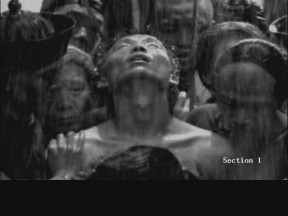
|
|
 |
|
 |
|
Chen Chieh Jen, Lingchi – Echoes of a Historical Photograph (video, 25 mins), 2002
Artist’s Statement:
“History has been lingchi-ed, that is, chopped and severed as human bodies. Violence is also gradually internalized, institutionalized and hidden. We do not see where we are and what was before us. We do not see the violence of history or that of the State either. That is the reason why we need to gaze at the images of horror and penetrate through them. Is the dark abyss of wounds not the very crack that we need to pass through so as to arrive at the state of full-realization and self-abandonment. In the early age of so called “history of photography” regions outside the western world played the role of “shooting objects”….I focus on how to reverse the subject of colonial photography history from people in front of a lens to the behind…”
This film is based on the famous 1905 photograph of a man being punished the Manchu way, by being cut into pieces for the crime of murder. His ecstatic expression is attributed to opium, which was administered to prolong the torture. Philosopher Georges Bataille discussed this photo extensively in his book The Tears of Eros and noted the correlations between the beauty of religious eroticism, divine ecstasy and the shocking horror of cruel torture. Chen’s cinematic close-ups of the victim’s face bring to mind images of blissful euphoria, homoeroticism, and religious crucifixion. Slow motion close-ups of a hand holding a knife, the grim expressions of the crowd of ponytailed bystanders, blood dripping down the crowd’s legs and flowing into the ground are eerie, but surprisingly not as violent as what one might expect considering Chen’s topic. …By linking the historical with the contemporary social and economic situation in Taiwan, Chen has created an extremely powerful work that links the past with the present, the fictive with the documentary. He is also specific to the local situation, while remaining universal.” (Susan Kendzulak)
Chen Chieh-jen (b. 1960 in Taoyuan, Taiwan) currently lives and works in Taipei, Taiwan. He has held solo exhibitions at the Taipei Fine Arts Museum; REDCAT art center in Los Angeles; the Museo Nacional Centro De Arte Reina Sofia in Madrid; the Asia Society in New York; and the Galerie nationale du Jeu de Paume in Paris. Group exhibitions include: the Venice Biennale, Biennale de Lyon, São Paulo Art Biennial, Liverpool Biennial, Biennale of Sydney, Istanbul Biennial, Taipei Biennial, Gwangju Biennale, Shanghai Biennale, Fukuoka Asian Art Triennale, and the Asia Pacific Triennial of Contemporary Art in Brisbane. Chen has also participated in photography festivals in Spain, Lisbon and Arles; and film festivals in London, Vancouver, Edinburgh and Rotterdam. Chen Chieh-jen was also the recipient of the Taiwan National Culture and Arts Foundation’s National Award for Arts in 2009, and the Korean Gwangju Biennale Special Award in 2000.
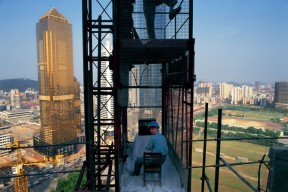
|
|
Liang Juhui, One Hour Game (video of performance installation, Skyscraper Construction Site, Tianhe, Guangzhou), 1996
Liang Juhui’s action “One Hour Game” disturbs the “normal process” of vertical urban expansion. In an elevator in a skyscraper under construction in Guangzhou’s new town, he sets up a video game and plays the game for an hour while the elevator continues to move up and down, carrying workers to work. The usual path of construction is hence disturbed. What is more interesting is that, here, there is a detournement of the metaphoric significance of the elevator through the intervention of the game. The elevator has become more like a sight-seeing elevator in an amusement park than a construction tool.
Liang Juhui was one of the founders of the Big Tail Elephant Working Group which emerged in Guangzhou during the early 1990’s. The members of the group, Chen Shaoxiong, Liang Juhui, Lin Yilin, and Xu Tan, presented regular performances and site-specific installations to directly intervene with the rapid social and political transformation of the city of Guangzhou. Being one of the first cities in which the new economic experiment of China took place, the rate of urban development in the early 90’s was unprecedented. Being keenly aware of the limited time frame of the economic open door policy, the order of the day for the vast majority was to accumulate as much wealth in the shortest time possible. During this time, popular culture and media from nearby Hong Kong as well as icons and merchandises from the “West” were dutifully consumed with little resistance shown. The direction of culture was adrift in a socialist turned ultra-capitalist society. The lack of official venues for hosting exhibitions or cultural events in the early 1990s meant the working group had to take their actions to the street. The Big Tail Elephant Working Group was crucial in preserving the integrity of critical artistic practice at such a unique historical juncture. They questioned the common ambition in the development of the city at the expense of denying social and moral values. Acutely aware of the ineffectiveness of the avant-garde movement of the early 1980s in China to refute official ideology, the group’s mission was less to initiate social change than to question the relevancy of contemporary art in everyday life. (Hou Hanru, “Barricades, Big Tail Elephant Working Group”)

|
|
 |
|
Zhang Peili, Just For You (video installation, 10 monitors) 1999
Artist’s Statement:
“This is a song nearly everyone knows how to sing, but very few people know, nor care who, in which year, in what country, composed it. It is a pop, an international symbol, a sign of happiness and a mark of time.”
As a central figure of the historical avant-garde 85 New Wave movement, Zhang Peili (b. 1957, Hangzhou) played a role in the founding of the Pond Society collective and became a core advocate of the school known as “rational painting.” In 1988 he completed what is commonly known as the first piece of video art created in China with 30 x 30, the infamous onscreen performance in which he smashed and repaired a square mirror, thus entering into a sustained investigation of video and related media including photography, installation, and electronic art. Typically adopting a minimal or reductive position that constructs an essential relationship between the aesthetics of video playback technology and the moving image itself, his video installation focuses on questions of perceived reality, media convention, individual agency, and spatial structure. In the years between 1988 and 2011 his video practice has undergone a number of significant shifts, beginning with the cool and contained painting of the mid-1980s and then moving into the aesthetics of boredom and control in his first video projects, including Document on Hygiene No. 3 (1991), in which the artist subdues and washes a chicken at the center of the frame. The mid-1990s saw classical reworkings of the relationship between content and spatial form, as withUncertain Pleasure II (1996), in which a hand scratches every corner of a naked body depicted only in fragmentary close-up shots across 10 channels, or Water: Standard Edition of Cihai (1991), for which a television announcer reads a dictionary entry as if it were the evening news. And then there are the appropriation and remix works, including not only Last Words but also Actors’ Lines, in which the gestures of revolutionary fervor depicted in a militaristic propaganda film are reframed to read almost romantically. Finally, more recent works involve interactive closed-loop systems like Hard Evidence No. 1 (2009) and theatrical scenes like A Gust of Wind (2008).
Zhang Peili was trained at the Zhejiang Academy of Fine Arts, graduating from the oil painting department in 1984 on the cusp of the aesthetic upheavals of that decade, and returned to the China Academy of Art as a professor in 2002, where he is currently responsible for the Embodied Media Studio of the School of Intermedia Art. His work is held by the collections of major global institutions including the Museum of Modern Art and the Centre Pompidou.
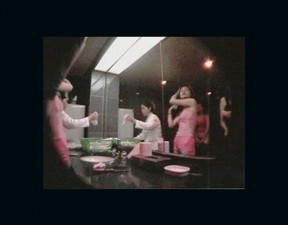
|
|
 |
|
Cui Xiuwen, Ladies Room (video), 2000
Artist Statement:
“While producing art works, I often angel sexuality to explore the problems of femininity and woman as part of the society. In Ladies, I chose the nightclub’s ladies’ room where the female workers from the club come to do -various activities. The scene showed a reality beyond one’s imagination. The scene reveals a very serious problem in society, and the problem will have its effects in history. On the surface, what I shot was about the state of women, but what I cared more was the social class behind scenes and how viewers read the work from cultural, historical and economic perspective. I chose the video to shoot this work, and the moving image expressed clearly the concept of time and space and content.”
Not particularly much to be seen here: some girls in front of a mirror readjusting dress and makeup. A much less stylish woman doing some clean up amongst them. These two images are stills from the 6’ 12” video Ladies Room by Cui Xiuwen. Trained as a painter, she has been focusing on themes of sexuality and gender early on, once shocking her audience with paintings of naked men whose genitals she particularly emphasized; something even more uncommon in China than in the West. At the occasion of a dance night out in a posh Beijing club, she realized that there is another side to the beautiful glamour girls on the dance floor. “Like hell in heaven, or heaven in hell.” as she puts it. Nevertheless, she felt that oil painting, her main artistic medium so far, would not be sufficient to express what she wanted to communicate. Shortly afterwards Cui came into contact with shooting video and had found her technique. Hiding a camera in the ladies’ room of an expensive Beijing night-club, she simply filmed the women in front of the mirror. They rearrange or change clothing, check out their appearance, admire themselves, re-do makeup and exchange gossip. It is only towards the end of the video that it becomes apparent that what seems to be ordinary girls enjoying an evening out in fact are prostitutes having a break from work. They also tuck away their money in bras and briefs, call their customers to arrange for new dates and catch their breath before returning to the clubroom. Cui does not comment on the scenes but offers a rare insight on one particular facet of the much-acclaimed China boom. Like Zhang Dali’s head down suspended plaster casts of migrant workers in Chinese Offspring the women in the lavatory do the lowest of services to those who profit most of the streams of money in contemporary China. And by doing so, add to the glamor of the scene. (Christof Buettner)
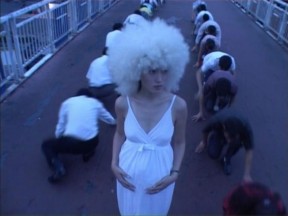
|
|
 |
|
 |
|
Jiang Zhi, Post Pause (video, 10 mins) 2004
Artist’s Statement:
“Paused moments of city life in Shenzhen. Faces and faces of twisted bodies humanity line up the streets and bridges of the city mark the cost of desires and consumerism in our contemporary culture. A Kafkaesque dreamscape of labyrinths and maze.”
…”In Shenzhen, the rapidly evolving city where I currently live, there is perhaps the highest proportion of dreamers in the whole country. Many came penniless and destitute, having brought with them only the determination to savagely scrape together a fast buck in a few short years. As the Deng Xiaoping saying goes: “The most virtuous ethic is the virtue to pursue development.” At any moment, the dreamers are ready to bring their dreams to fruition, and apparently willing to do so for any price.”… “In the city streets, I might encounter many strange and wonderful things. Those people we see are like actors on a stage. Those sets and scenes look no different from a directed play in progress. It was only much later that I become conscious of the fact that this is reality in its true form. That one individual with that group of people over there, with the motions they are acting out, are all controlled by a hand. This may originate from organizational leaders behind the scene, their bosses, their husbands, mistresses, or perhaps it might be the factory, the company, or even these people themselves… However, I am only directing a small segment in this short film. I would like to suggest this is a response to the issues brought forth by the characters. In those embarrassing realities yet to receive people’s attention there is also the fantasy world that we are so insistently infatuated with – only when I can examine these two worlds in parallel may the prying curiosity in me be satisfied.”
Jiang Zhi was born in Yuanjiang, Hunan in 1971. Graduated from China Academy of Fine Art in 1995, now he is living and working in Shenzhen and Beijin, China. Jiang Zhi’s works concern contemporary social reality in China. His works have an insight into human civilization and China society, bringing the public the introspection in an amusing form.
PRESS PLAY VIDEO ON IkonoTV
IMAGE GALLERY:


 Back to Homepage
Back to Homepage